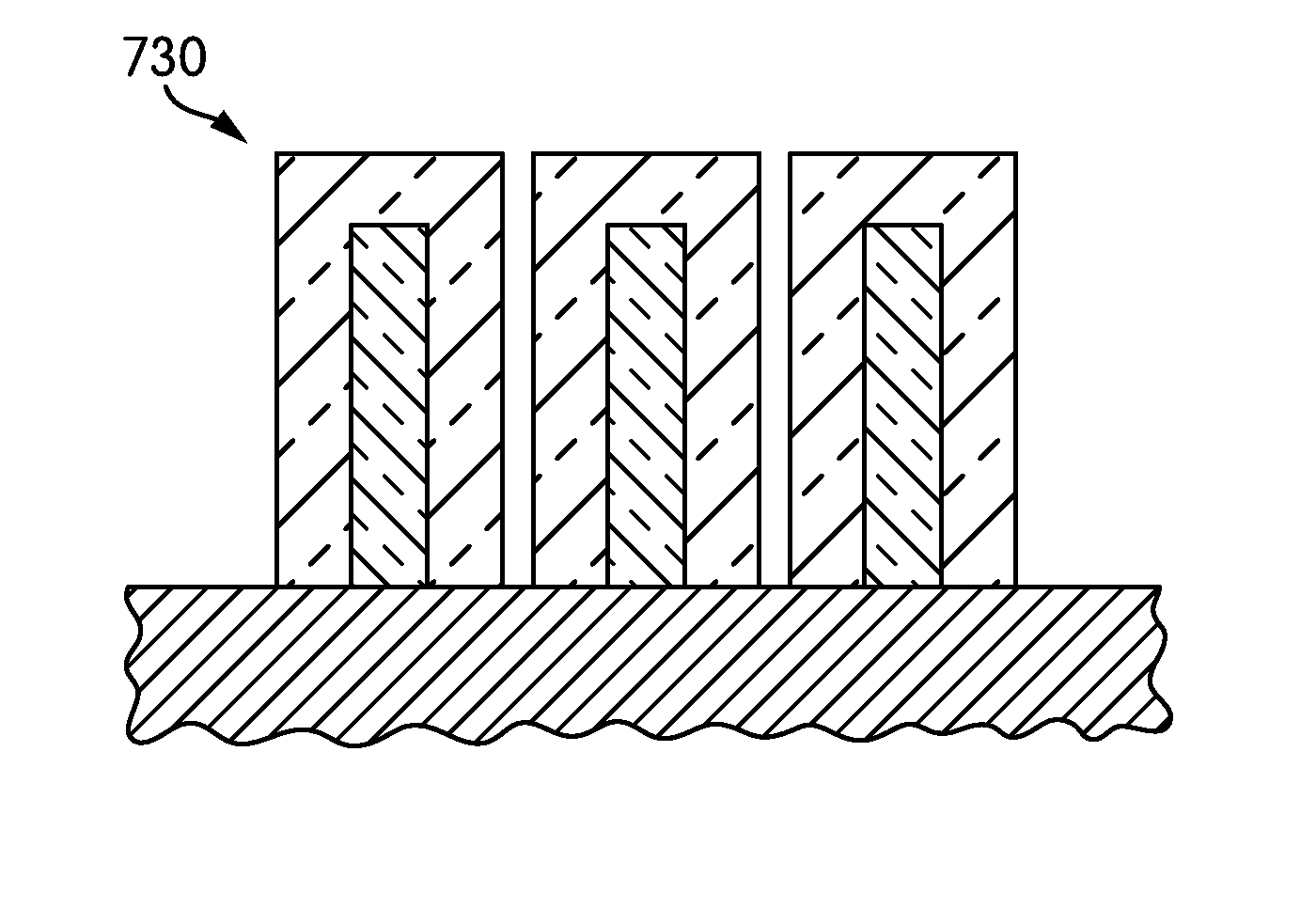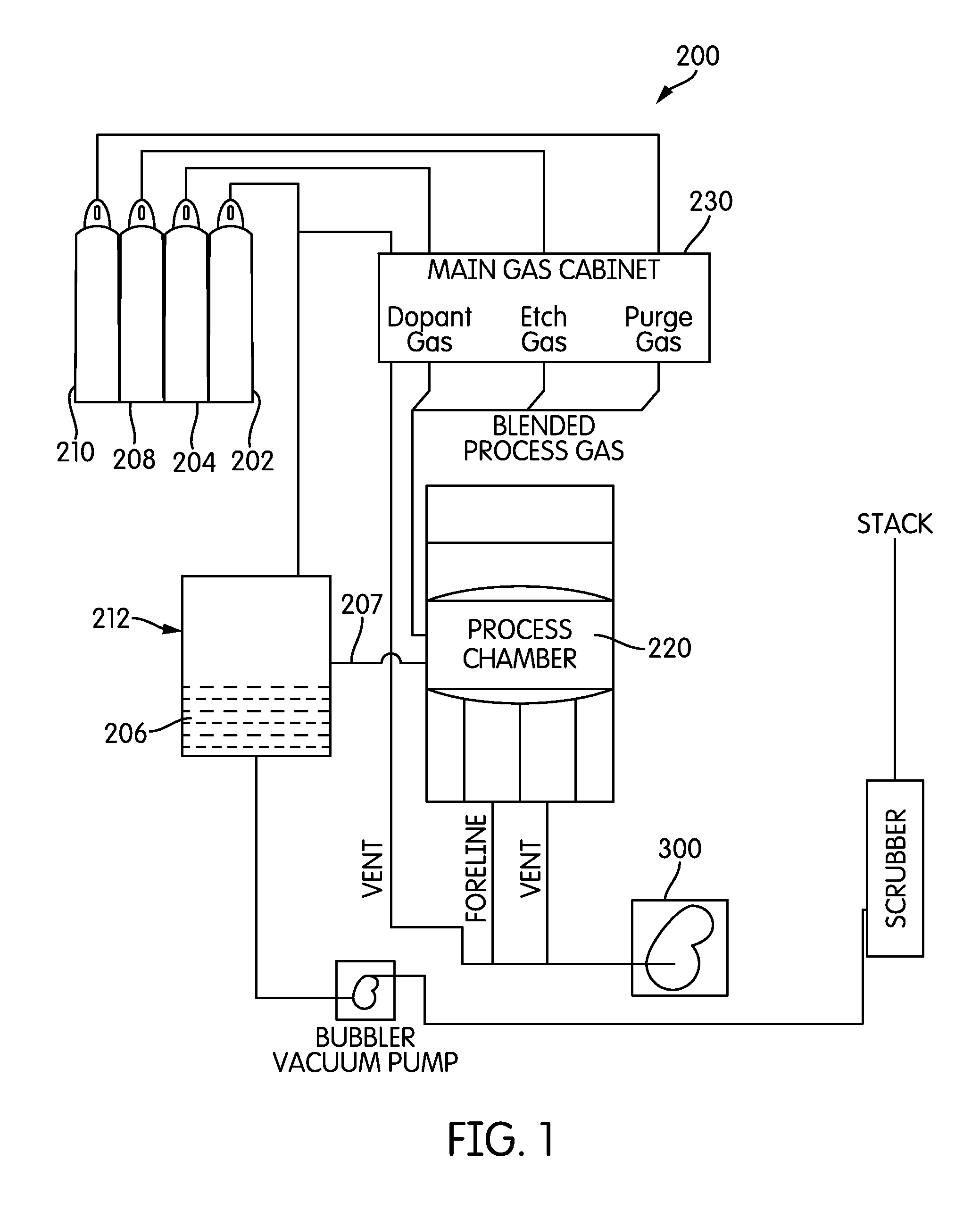Methods for Selective and Conformal Epitaxy of Highly Doped Si-containing Materials for Three Dimensional Structures
a highly doped, conformal technology, applied in the direction of basic electric elements, electrical apparatus, semiconductor devices, etc., can solve the problems of increasing the subthreshold leakage at the corners, no viable option of continuing, and deposition of epitaxy materials, and achieve excellent crystal quality
- Summary
- Abstract
- Description
- Claims
- Application Information
AI Technical Summary
Benefits of technology
Problems solved by technology
Method used
Image
Examples
example 1
Tetrasilane CDE Net Growth Per Cycle Impact on FinFET Crystallographic Planes
[0088]As discussed previously, normal selective epitaxial growth (SEG) utilizing dichlorosilane chemistry (DSC) typically results in a saw-tooth morphology 300, as seen in FIG. 3A. It has been discovered that by controlling tetrasilane cycle deposition etch (CDE) net growth per cycle no defective layers is obtained for FinFET source / drain region and epitaxial doped-silicon growth on in. By using tetrasilane CDE, as disclosed herein, good morphology doped-silicon growth is achieved on the FIN and no facet formation under silicide layer is apparent. This ultimately has a benefit of reducing contact resistivity.
[0089]In order to reduce the net growth per cycle. (5-25 Å / cycle) there are two methods. First growth thickness may be reduced by deposition time or growth rate and second, increase etched thickness by etching time or etch rate. Both methods or a combination of the two are effective at reducing the net ...
example 2
Process for the Production of Highly Doped SiAs Epitaxy Layer
[0096]The present invention describes N-type doping with tetrasilane as Si precursor, eliminates the N type doping surface segregation, growth rate poisoning effect. Reducing these effects thus leads to same growth rates and doping concentrations on both 100 and 110 crystallographic planes. Cyclical deposition and etch (CDE) reduces defect level.
[0097]After loading a substrate into the process chamber, the conditions in the process chamber are adjusted to a predetermined temperature and pressure. In this particular example the process chamber is maintained at a temperature below about 550° C. during deposition and etching. The process chamber was maintained at a pressure of about 10 Torr. The pressure may fluctuate during and between process steps, but is generally maintained constant.
[0098]During the deposition process the substrate is exposed to a tetrasilane to form an epitaxial layer at a rate of about 20 sccm (0.11 g / ...
example 3
Obtaining Selectivity and Uniform Fin Merge with CDE
[0104]As discussed previously, the fabrication of uniform, ultra thin fins is one of the key challenges in FinFET fabrication. Due to non-ideal anisotropic over etch, the epitaxial layer 601 deposited on the fins 604, 604′ and 604″ can end up having a slightly triangular shape whereby voids 607 are created especially at the bottom of the Fins. Once the facets merge at the top 606, the reactant gases cannot reach the bottom of the Fin resulting in voids 607, see FIG. 6A. Concave and convex surfaces can also end up during typical fabrication processes.
[0105]In an embodiment, according to the present invention a uniform Fin merge 610 is achieved during the higher silane CDE process by etching back the Fins 602 at certain intervals during the CDE process thereby selectively targeting the top of the epi growth 602′ thus keeping a space 605 between the fins 604, 604′ and 604″ open so a bottom up fill can occur, see FIG. 6B. This etch bac...
PUM
| Property | Measurement | Unit |
|---|---|---|
| temperature | aaaaa | aaaaa |
| temperature | aaaaa | aaaaa |
| pressure | aaaaa | aaaaa |
Abstract
Description
Claims
Application Information
 Login to View More
Login to View More - R&D
- Intellectual Property
- Life Sciences
- Materials
- Tech Scout
- Unparalleled Data Quality
- Higher Quality Content
- 60% Fewer Hallucinations
Browse by: Latest US Patents, China's latest patents, Technical Efficacy Thesaurus, Application Domain, Technology Topic, Popular Technical Reports.
© 2025 PatSnap. All rights reserved.Legal|Privacy policy|Modern Slavery Act Transparency Statement|Sitemap|About US| Contact US: help@patsnap.com



